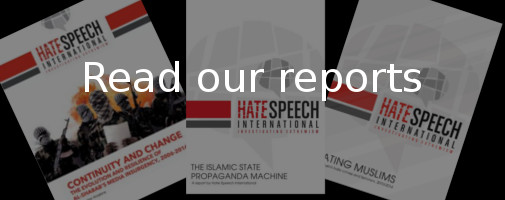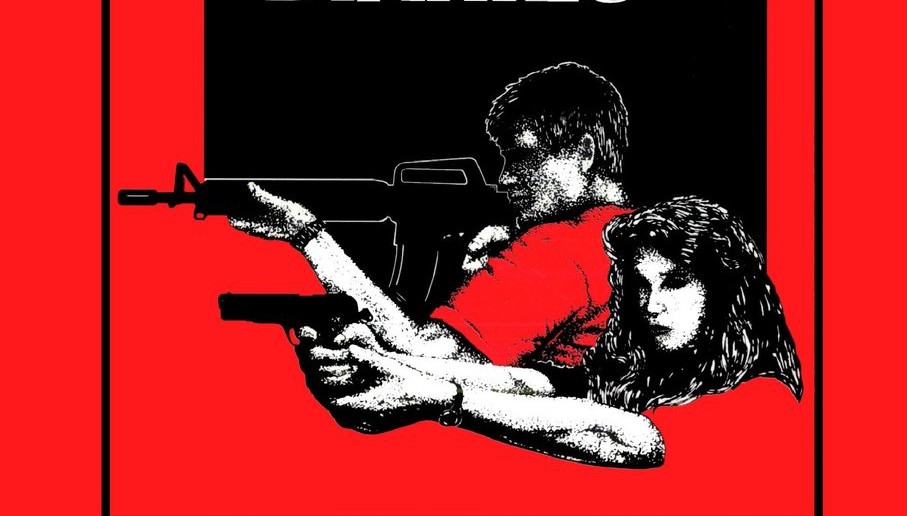
The Oak. Source: The Searchlight Archive.
The trial of Thomas Mair, and his conviction for the murder of Jo Cox, highlights many of the risks posed by British extreme right activism.
Paul Jackson
It can produce a milieu that normalises the most extreme forms of hate, licencing violence linked to a political cause. As they have emerged, details of Mair’s life, while still fragmentary, demonstrate that he was a more that the solitary, misunderstood figure of tabloid media cliché. He was a man who engaged with extreme right cultures for many years, demonstrating the undoubtedly political dimension to what was undoubtedly an act of terrorism.
In terms of drawing out a picture of the ideas that animated this activism, his trial has thrown up some intriguing details too. For example, we now know that his shelves featured books by noted scholars of the Third Reich, and even Holocaust denial, such as Michael Burleigh and Deborah Liptsadt. He also read Richard Thurlow’s excellent overview Fascism in Britain. I have recommended all of these books to my students – however, many of his books I would not.
For example, we also learned that he owned a copy of Arthur Kemp’s telephone-directory sized March of the Titans: The Compete History of the White Race. This is book by a leading neo-Nazi activist of the 1990s that promotes ideas of white superiority in a variety of ways. It is steeped in Holocaust denial, as well as pseudo-racial theory. As its back page alone explains, ‘revealed in this work is the one true cause of the rise and fall of the world’s great empires – that all civilisations rise and fall according to their racial homogeneity and nothing else’. It then adds that ‘a nation can survive wars, defeats, natural catastrophes, but not racial dissolution’.
Also promoted by the British National Party in the 2000s, March of the Titans argues that contemporary western civilisation is on the verge of collapse, a crisis that has developed since the defeat of the Nazi regime in 1945. Its closing sections even project into the future the rebirth of the white race in some new form, after a period of transition. This is a classic fantasy driving the extreme right, and often the more ideologically committed will develop a vision for elemental of this type, to legitimise their own actions. It can be found in Breivik’s manifesto, for example, while Hitler’s fantasy of the new Thousand Year Reich also epitomises the trope.
Mair also read literature produced by the Springbok Club, such as S.A. Patriot. This was a publication developed by yet another overly white supremacist organisation, this time one that looked to the history of Apartheid in South Africa for its interpretation of white superiority. Mair even wrote to the magazine in 1991, denouncing the ways the politics of South Africa were being covered in the British media, as well as complaining about the deaths of loyalist paramilitaries. In 1999, he sent them another letter, claiming that it was ‘not the Black masses but White liberals and traitors’ who were ‘the enemies of the old Apartheid system’.
Aside from these reported examples, the Searchlight Archive at the University of Northampton has details on some further elements of the wider neo-Nazi milieu in Britain that Mair immersed himself within. In particular, Mair was interested in the American neo-Nazi organisation the National Alliance, a group who exerted influence over the British extreme right in the 1990s. In 1995, its leader, William Pierce, addressed a British National Party event, while his trashy novella, The Turner Diaries was a regular feature of reading lists of British neo-Nazis at this time, and after. The nail-bomber David Copeland was another in part inspired by this book, while Mair himself seems to have drawn influence from Copeland.
Øyvind Strømmen writes on the Turner Diaries: The impact of a racist fable
Also, receipts published by the Southern Poverty Law Center show Mair bought a range of material from the American neo-Nazi groups the National Alliance, including bomb making manuals, magazines such as Free Speech, and other items too, amounting to about £500 in total. Also, around the time Mair was buying these materials we know he lived about a mile away from the leader of the National Alliance (U.K.), Paul Jeffries. We do not have clear evidence of a linkup between the pair, but then who would have been looking for this at this time?
Little is known about this fringe British offshoot of the National Alliance, but in the Searchlight Archive there are copies of the magazine of the National Alliance (U.K.) from the 1990s, The Oak. While this may or may not have been read by Mair, it certainly reveals the types of ideas that the National Alliance promoted in the 1990s.
The Oak was priced at £6.00 for four editions, and was sold by another tiny organisation, Life Rune Books. The Oak’s logo featured the life rune symbol used by the US National Alliance, and described this symbol as important for the following reason:
It comes from an ancient alphabet, or futhark, used in Northern Europe for many centuries before the general adoption of the Roman alphabet there. The Life Rune signifies life, creation, birth, rebirth and renewal. It expresses in a single symbol the raison d’etre of the National Alliance and the movement of Aryan renewal.
Such statements epitomise the ways extreme right ideologies steep their hate in a language of creativity, and regeneration, given some form of ‘higher’ purpose via the evocation of mythic ideals. Evidence from Mair’s trial suggested he too had an interest in such runes.
Politicians were regularly demonised in The Oak, while a vision for radical change in the future was also talked up. One edition of The Oak featured an article called ‘The Future is Ours’, which predicted:
A storm is coming and we know we are not the only ones to feel it: a storm which will forever change the face of our land. But we also know, however, that the rot is entrenched far deeper than the got-to-look-out-for-number-one mindset which epitomises the reckless abandon of Whitehall’s bureaucrat-politicians …
Such statements both epitomise the vision of elemental change inspiring neo-Nazi activism, as well as the rejection of the political class in such cultures. Politicians become symbols of a deeper ‘rot’ in the contemporary system.
Another edition of The Oak, from March 1994, featured a telling essay by National Alliance founder William Pierce. This commented, in a seemingly critical way, on the role of violence and an armed uprising. For example, he explained that ‘I really do not believe that the proper time has come for taking up the gun against our enemies’.
The actual article was far from an unequivocal rejection of political violence though. Pierce also explained he rejected violence as a tactic was because such activity was likely lead to the arrest of the protagonist, probably before their attack could be carried out. While in prison such foiled activists could do good work trying to radicalise other white people, Pierce suggested, but concluded that ultimately this was not the best strategy for the movement to adopt.
On the underlying issue of whether political violence was legitimate, Pierce also explained that it ‘does not matter that we have every moral justification for doing so, or that we are provoked beyond endurance’, he still formally advised against violence. Nevertheless, he still felt the need to expand on the role of political violence in activism in other ways too.
This included suggesting such violence could have a role if used in the right way, to produce a climate of fear among those who are betraying white people. Attacking directly those who were deemed racial enemies, such as Jewish people, was pointless, he explained, but assassinations of those who were seen as traitors of the white race, such as white politicians, clergymen and even TV personalities could be morally justifiable.
He also concluded that, if carried out, then such attacks also needed to be sophisticated, and stated that many were foiled as vain protagonists spent more time amassing arms than developing well thought out operations.
As he explained, with ostensible reluctance:
In summary, if you must turn to violent action now, then at least take care that when we read of your acts in the newspapers we feel pride rather than embarrassment. Better discipline yourself and avoid violence and illegality altogether at this time, and instead turn your energies into our tasks of infrastructure building and public education. The time for other types of activity will come, but it is not here yet.
Again, there is a clearly extreme sentiment wrapped up in this sort of purposefully ambiguous statement, one that only half-heatedly tells people not to act violently. Pierce’s phrasing, typical of such leader voices, is steeped in acceptance that violence can be morally justifiable. However, the barriers stopping it being justified are merely ones of pragmatism, and it not being the ‘right time’.
Moreover, this type of statement clearly allows another who reads it, and who does feel the time is right to act violently, to imagine they could be the exceptional figure, the one who is more professional than the others. Perhaps the reader is the one who could develop an act of solo actor terrorism in a way that was not an ‘embarrassment’ to idols such as Pierce? Elsewhere in its pages, The Oak glamorised the idea that its readers, by choosing to engage with such an extreme magazine, were on their way to becoming embodiments of a ‘superman’ figure, inspired by ‘nature’s will’.
Interestingly, Life Rune Books was aware that it was flirting with illegal material. It used the following disclaimer to try and absolve itself of responsibility for the radicalising nature of such publications:
[We have] … no wish to incite anyone in any way to what the renegade authorities of the UK regard as “racial hatred”, and to prevent any possible breach of the terms of the Race Relations / Public Order / Criminal Justice Acts 1965 – 1994, we can only supply items to: PERSONS WHO ARE ABLE TO TRUTHFULLY ATTEST THAT THEY ARE BEYOND BEING INFLUENCED TO “RACIAL HATRED” BY ANY ITEM ORDERED OR OBTAINED FROM LIFE RUNE BOOKS.
Life Rune Books, and The Oak, were all part of the fragmented, extreme right milieu of the 1990s in Britain, which included groups ranging from the National Front to Combat 18. Mair was also part of this world at this time, though his exact role within it will probably remain unknown. The Oak and its linkups between others groups are better known though. Epitomising a connection between the extremes and the larger groups of the 1990s, John Tyndall, founder and then leader of the British National Party, also wrote to The Oak at this time, to explain that he agreed with practically all elements of Pierce’s ideas and greatly supported the National Alliance. A year later Pierce came to the UK and addressed the BNP.
Magazines such as The Oak exemplify the type of culture that Mair found fascinating. We do not know he read the articles from it cited in this blog, but they do illustrate the types of messages he engaged with. He is, and will probably remain, a gnomic figure too, given his unwillingness to contribute to police interviews or his trial.
Mair is also an evocative example of a wider phenomenon. There have been many other extreme right activists, perhaps 50, in the past few years who have been radicalised by this type of mind-set, yet they remain under-researched. To tackle the impact of extreme right violence, more explorations of its recent history, and its ideologies, are needed. This will help create a better understanding of the types of clandestine environments that help inspire a figure such as Mair to engage in an act of terrorism.
This article was based on material taken from The Searchlight Archive, a major collection of material related to extreme right at the University of Northampton. Click here to find out more about this collection. It was previously published on Paul Jackson’s blog, and remains under his copyright.


 Print Friendly
Print Friendly







No comments yet.